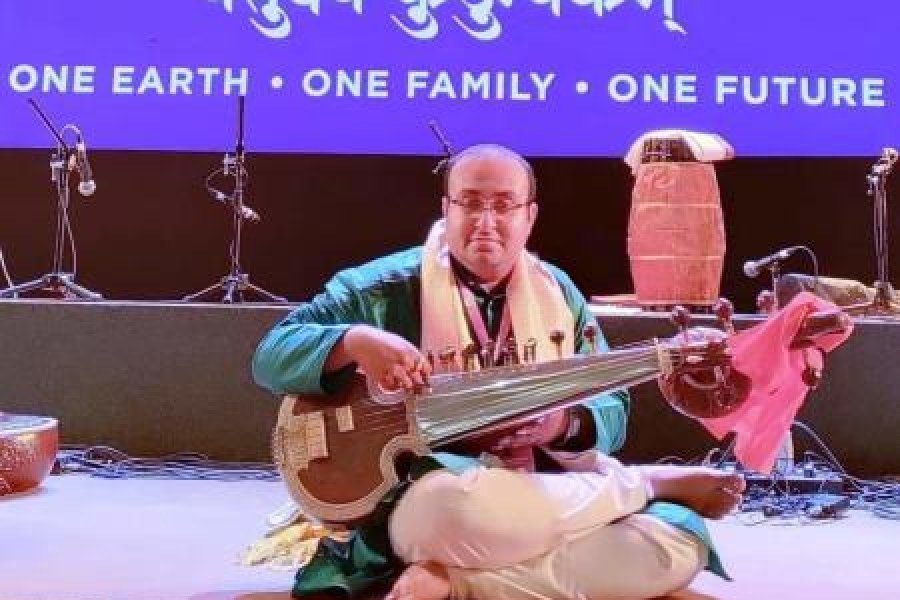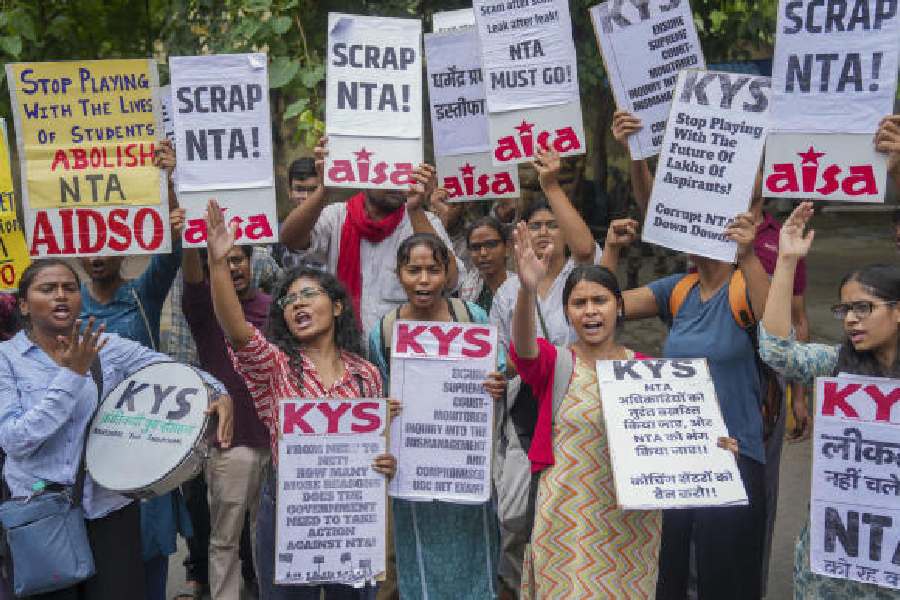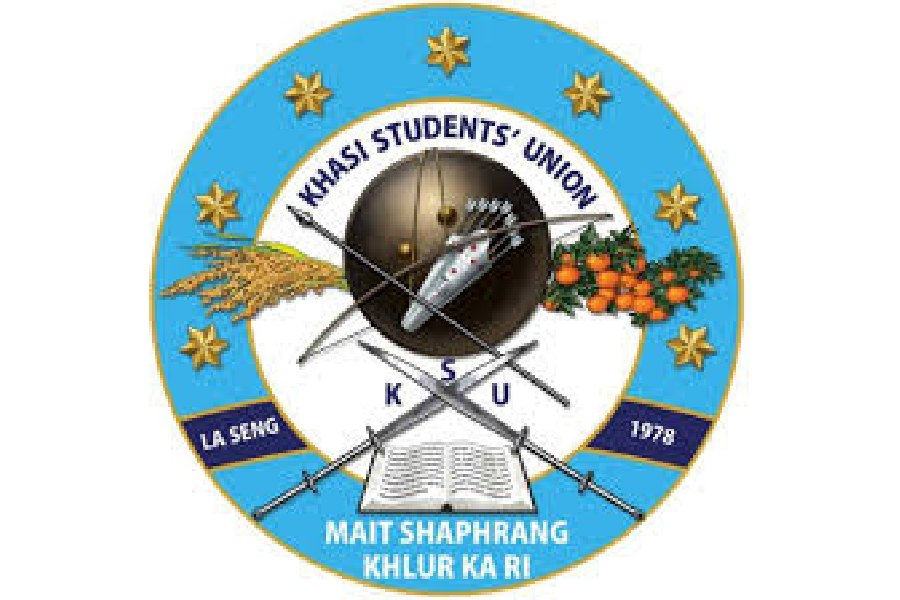An engineer and with an MBA degree, Joydeep Mukherjee has worked as a full-time market research professional for over a decade. Also a sarod player, he is the recipient of Sangeet Natak Akademi’s prestigious Ustad Bismillah Khan Award, among numerous other awards. His passion for Indian classical music has led him to revive and restore some extinct traditional classical music instruments that existed centuries ago. A The Telegraph chat with the instrumentalist who wants to connect India’s youth with the country’s rich and diverse musical past.
Tell us about your initiation into Indian classical music.
I am from a family of music lovers, but the first professional musician in my family. My Guruji, Pranab Kumar Naha, a disciple of sarod maestro Pandit Radhika Mohan Maitra, would come home to give me sarod lessons when I was a child. As I grew older, I participated in various music competitions and won first prize in most of them. But as with boys from ordinary middle-class families, I was never told that I could pursue it as a profession. So I did my engineering and MBA and worked as a full-time market research professional for over a decade. However, music was my passion and I made sure that I kept practising over the years.
How did you become interested in the revival of instruments and why did you decide to take on this mammoth task?
I started studying and researching old instruments since 2015. My Guru had told me to play an instrument with higher resonance than the sarod, to help me overcome a problem I faced while playing the alaap, perhaps a little too hurriedly. He suggested that I play the sursingar, an 18th century instrument created by Zafar Khan, a descendant of Tansen, of which the sarod is a modern and improved version. The sursingar also had its origin in another instrument called the Tanseni rabab, which was created by Tansen in the 16th century as a modification of the Afghani rabab.
As original sursingars were too large, heavy and difficult to play, I tried other variations. Eventually, in 2019, I found a sursingar that had sympathetic strings and then customised it. I could not only retain the tonal quality of the instrument but found it easier to play a prolonged alaap on this sursingar.
Now in 1948, Pandit Radhika Mohan Maitra had invented an instrument that had the features of both the sarod and sursingar. It was named mohanveena by the then chief producer of All India Radio, Thakur Jaideva Singh. Unfortunately, after the former’s death in 1981, this instrument was not played much by anyone and was on the verge of becoming extinct. So I set to work reviving that as well.
But I always kept in mind the fact that when I revived these instruments, I should bring them up to par with modern instruments. Otherwise, audiences would not want to listen to the sursingar or mohanveena.
Initially, the revival of these ancient instruments helped me overcome my difficulty in playing the sarod. However, it has a far more important purpose in making the new generation aware of ancient Indian music heritage. These old instruments were, till the 19th century, very much a part of the Senia Shahjehanpur Gharana to which I belong, and so I thought that they must also be known and taken forward. For the last five years, I have started presenting public performances with these rare instruments. Before I begin my recital, I take a few minutes to share with the audience the history of these instruments.
Can you take us through the process of reviving the instruments? Did you receive any institutional help?
I finished the revival of sursingar and mohanveena four years ago. It was more difficult to revive the Tanseni rabab and sur-rabab (created in Bengal by Ustad Abdullah Khan of the Senia Shahjehanpur Gharana by blending three instruments — sursingar, sarod and Tanseni rabab) because unfortunately we have few, poor quality archival recordings of these two instruments and it was very difficult to judge the sound and tonal quality of these instruments.
Having played the sarod for many years, I had an idea of the kind of wood the structure should be made of. My engineering background also helped me ascertain the right length, width and depth of the sound box. Still, it took me more than a year to find a suitable block of seasoned, 120-year-old wood to design the structure of these two instruments. Anyhow, I needed to hear their original sounds so I could decide what kind of strings to use, what material they should be made of, and so on. I wrote to two institutions for help in my research — Sangeet Natak Akademi and Prasar Bharati — who would have recordings of Ustad Alauddin Khan, Pandit Radhika Mohan Maitra and other greats of the early 20th century, in their archives. The recordings that I obtained from them helped me understand exactly what sound quality the instruments being revived should have. Some modifications in terms of the material of the structure also became necessary. Instead of ivory, I used ebony wood for the bridge of the instruments. I also replaced the pure wooden finger-board of the Tanseni rabab with rosewood, to get a flawless sound quality.
When can audiences expect a public performance of these newly revived instruments?
The sursingar and mohanveena were revived four years ago. These days, whenever I present a sarod recital, I perform the alaap on the sursingar, then play a piece on the mohanveena before I move on to the sarod. My performance at ICCR on July 12 on the theme of ‘the musical heritage of Bharat’ also featured these two revived instruments.
I have not yet given any performance with the Tanseni rabab and sur-rabab as these instruments have been revived just recently. However, if all goes well, I hope to present an inaugural performance of these two instruments in September at the Ramakrishna Mission Institute of Culture.
Do you teach your students these revived instruments too, apart from sarod?
I started giving sarod training to students since 2019 when my Guru allowed me to do so. From around 20 of my students, at least four or five are now also training in the sursingar. A couple of them are learning to play the mohanveena. Sursingars have also been exported to USA and France so that my students there can learn to play this instrument.
How do you envision the future of classical music, particularly instrumental music?
According to me, the level of commitment of youngsters taking up classical instrumental music is very high. One of the reasons for this may be because a classical instrument like a sarod is 10 times more expensive than say, an instrument like the guitar that you can easily purchase online. Since they have made a substantial investment, students are more serious about learning and practising these instruments.
Contrary to common belief, I foresee a very bright future for classical music. More classical music concerts and festivals are being organised now than in the past, and drawing full-house audiences.
Musically speaking, what’s next on the horizon for you?
In the next three or four years, along with the sursingar and mohanveena, I wish to establish Tanseni rabab and sur rabab as classical instruments. Apart from this, I am currently doing a fellowship with the Ministry of Culture, inspired by a project of the late sarod maestro Buddhadev Das Gupta, of trying to play the tunes of Tagore songs in the form of a classical bandish. I also wish to explore the music creations of Satyajit Ray, which were mainly influenced by Western traditions, from the perspective of Indian classical music.










